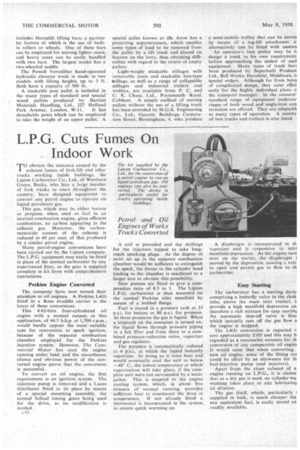L.P.G. Cuts Fumes On Indoor Work
Page 68

If you've noticed an error in this article please click here to report it so we can fix it.
TO obviate the nuisance caused by the exhaust fumes of fork-lift and other trucks working inside buildings, the Lipton Carburettor Co., Ltd., of Wooburn Green, Bucks. who hire a large number of fork trucks to users throughout the country, have designed equipment to convert any petrol engine to operate on liquid petroleum gas.
This gas, which may be either butane or propane, when used as fuel in an internal-combustion engine, gives efficient combustion, no carbon appearing in the exhaust gas. Moreover, the carbonmonoxide content , of the exhaust is reduced to 40 per cent. of that produced by a similar petrol engine.
" Many petrol-engine conversions have been carried out by the Lipton company. The L.P.G. equipment may easily be fitted in place of the normal carburetter by any experienced fitter, as the gear is supplied complete in kit form with comprehensive instructions.
Perkins Engine Converted
The company have now turned their attention to oil engines. A Perkins L4(I) fitted in a Ross straddle carrier is' the latest of these conversions. —
This 4.42-litre four-cylindered oil engine with a normal output, in this application, of 46.5 b.h.p. at 1,500 r.p.m., would hardly appear the most suitable type for conversion to _spark ignition, because of the separate combustion chamber employed for the Perkins injection system. However, The Commercial Motor has seen the engine running under load, and the smoothness, silence and obvious power of the converted engine prove that the conversion is successful.
To convert an oil engine, the first requirement is an ignition system. The injection pump is removed and a Lucas distributor fitted in its place by means of a special mounting assembly, the normal helical timing gears being used for the drive, as no modification is needed.
(-11 A coil is provided and the drillings for the injectors tapped to take longreach sparking plugs. As the degree of swirl set up in the separate combustion chamber would be sufficient to extinguish the spark, the throat in the cylinder head leading to the chamber is machined to a larger size tO obviate this possibility.
New pistons are fitted to give a cornpression ratio of 8.5 to I. The Lipton L.P.G. carburetter is then mounted on the normal Perkins inlet manifold by means of a welded flange.
Fuel is stored in a pressure tank at 35 p.s.i. for butane or 80 p.s.i. for propane. At these pressures the gas is liquid. When a stopcock on the container is turned on, the liquid flows through pressure piping to a felt filter and from there to a combined pressure-reduction valve, vaporizer and gas regulator.
The pressure is automatically reduced to 4 p.s.i., at which the liquid instantly vaporizes. In doing so it loses heat and would eventually cool the unit to below —40° C., the lowest temperature at which vaporization will take place, if the complete unit were not surrounded by a•water jacket. This is coupled to the engine cooling system, which, in about five minutes of normal running, provides sufficient heat to counteract the drop in temperature. If not already fitted a thermostat is incorporated in the system. to ensure quick warming up. A diaphragm is incorporated in th vaporizer and is responsive to inlet manifold depression. As the engine turn over on the starter, the diaphragm i moved by the depression, causing a valv to open and permit gas to flow to th carburetter.
Easy Starting The carburetter has a starting devic comprising a butterfly valve in the chok tube, above the main inlet venturi, tu provide a high manifold depression an therefore a rich mixture for easy startini An automatic shut-off valve is fine. which instantly cuts off the gas flow a the engine is stopped.
The 14(1) conversion is expected t. cost approximately £165 and this may b regarded as a reasonable estimate for th conversion of any comparable oil engine It would seem that when converting new oil engine, some of the fitting cos could be offset by an allowance for th fuel-injection pump (and injectors).
Apart from the clean exhaust of a engine running on L.P.G., it is claime that as a dry gas is used, no cylinder-wa: washing takes place or any lubricating oil dilution.
The gas itself, which, particularly i supplied in bulk,, is much cheaper tha any equivalent fuel, is easily stored an readily available.












































































































